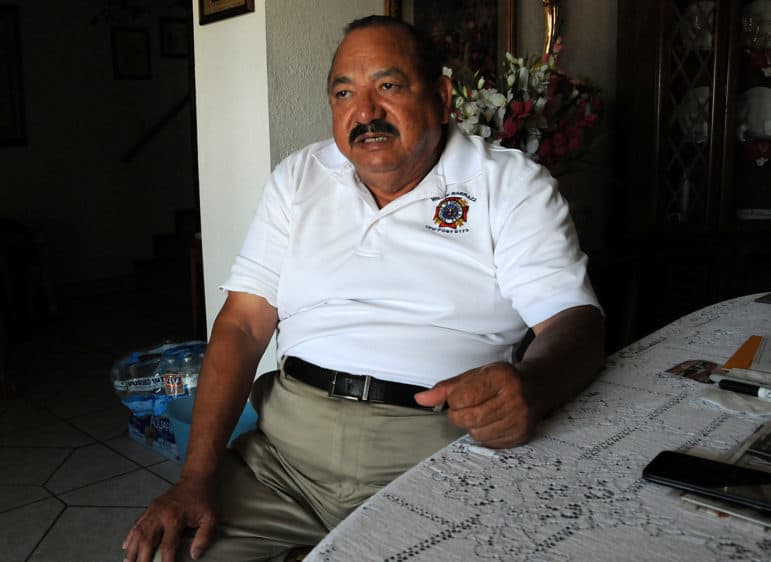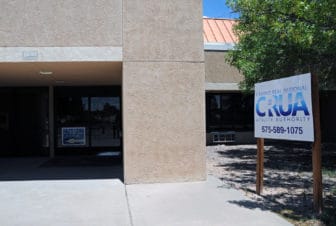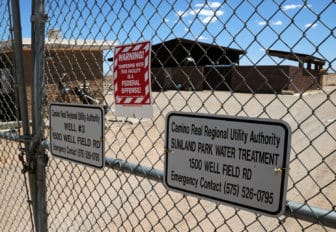
Heath Haussamen / NMPolitics.net
Ramon Sierra, a resident of the Anapra neighborhood in Sunland Park, is among those pushing for better communication and improvements to the region’s water system. “It is quite hard to say I trust them. I still buy my bottled water,” he said.
SUNLAND PARK — Serving the Southern New Mexico border communities of Sunland Park and Santa Teresa, the Camino Real Regional Utility Authority (CRRUA) is under pressure on multiple fronts.
Recent revelations of levels of arsenic that were above health standards in the public utility’s water, Clean Water Act violations, and management troubles have all drawn the attention of Southern New Mexico elected officials as well as state and federal environmental regulators, even to the extent that the construction of an urgently needed new wastewater treatment plant is on indefinite hold.
Most importantly, CRRUA’s credibility with local residents who use the system’s water drawn from underground wells is in tatters.
In a letter to utility customers that followed an April 21 notification about arsenic problems (sent per Safe Drinking Water Act regulations), CRUUA Executive Director Brent Westmoreland listed water sample test results that showed a consistent pattern of arsenic violations from February 2012 to April 2016. Multiple violations were detected in all parts of the utility’s water system, including wells, the two arsenic treatment plants, and a storage tank.
The Dallas office of the U.S. Environmental Protection Agency (EPA) told Frontera NorteSur (FNS) that “the latest data” in their possession shows that CRRUA “either missed or did not” correctly sample arsenic three times within the past three years. CRRUA also failed to issue public advisory notices for three quarters. Such samples and notifications are required by law. The EPA underscored that quarterly samples are required at four sites.
Health studies have linked long-term exposure to arsenic, a naturally occurring substance commonly found in groundwater in New Mexico, Mexico and other regions of the world, to cancer, skin disorders, high blood pressure and other maladies.
Although CRRUA has now declared two arsenic treatment plants repaired, and arsenic levels in community water supplies within the health standards, Sunland Park City Manager Bob Gallagher considers the utility’s response inadequate. The city government plans to begin its own independent testing of water from home faucets and storage tanks this month, Gallagher told FNS.
Approved by the Sunland Park City Council, the testing will cover all council districts, with special attention placed on the low-income neighborhood of Anapra, the oldest section of the city and a place where many seniors with difficult access to alternative water supplies are burdened with antiquated water infrastructure.
Additionally, Sunland Park will test water in the unincorporated community of Santa Teresa to the west of the city limits, which is also served by CRRUA.
“We’re reaching out to our neighbors and saying, we’re doing this and we’re adding you,” Gallagher said, explaining the water testing will be outsourced to Wilson and Company, which will then send the samples to a certified lab that will provide copies of the results to both Sunland Park and the New Mexico Environment Department (NMED). The results will be publicized in local media, he said.
Acknowledging that the testing won’t come cheap, Gallagher estimated a monthly price tag between $1,000 and $1,500. He said Sunland Park would insist that CRRUA reimburse city coffers — a proposition the utility initially did not accept.
“I just hope and pray it’s OK,” Gallagher said about Sunland Park’s water quality. “If it’s OK, what’s wrong with bending over backwards and being conservative with someone’s safety?”
In response to an earlier rebuff to a proposal by Sunland Park officials that CRRUA provide bottled water to seniors, who can be more vulnerable to arsenic poisoning, Gallagher said “we are going to have to revisit that subject matter if the testing results (show) they are not in compliance.” Underlying the arsenic controversy is the ongoing mystery of precisely why and for how long CRRUA’s two treatment plants were down.
An investigation by NMED in May found that one of CRRUA’s two arsenic treatment plants, the facility intended to service the Santa Teresa industrial zone, was down for “maybe more than two years” — considerably longer than the six months originally reported by Westmoreland to the CRRUA Board of Directors.
In the case of the Sunland Park arsenic treatment plant, which services a residential area, the NMED attributed a down time estimated at more than one year to a switch that wasn’t correctly pre-programmed, causing the plant to stop functioning after about one hour. According to Gallagher, the plant was out of commission for “at least a year-and-a-half.”
‘It’s kind of hard to return to trust’
Arsenic was a hot topic at last month’s CRRUA board meeting. Longtime Sunland Park resident Ramon Sierra and others were surprised to hear Westmoreland say the arsenic plants had been fixed since May 26.
Though still skeptical about CRRUA’s ability to do its job, Sierra was nevertheless willing to give the local utility a chance. “I believe you guys are progressive and doing things. I do,” he told the board. “But why not ask for help?”
A full CRRUA Board of Directors was present to hear Sierra’s concerns. The members include Sunland Park City Councilors Ken Giove and Francisco Jayme; Joshua Orozco, board chairman; District 34 state Rep. Bill Gomez; Doña Ana County Commissioners David Garcia and Benjamin Rawson; and Susan Yturralde, representative of New Mexico state Sen. Joseph Cervantes.
Gomez said at the meeting that he had not known about arsenic problems or been informed about them in a timely fashion. Westmoreland said CRRUA, in conjunction with NMED, was now on top of water sample testing.
“I understand they are on top of it,” Giove said. “What about six months from now? What about a year from now? It’s kind of hard to return trust when you don’t have any.”
Giove noted violations dating back to 2012. “It doesn’t make sense,” he said, that treatment plants were not functioning and board members and residents weren’t informed.
“You’re right. It doesn’t make sense, but it happened,” Westmoreland conceded at the meeting, describing how he assumed his job late last year amid organizational disarray.
“I started asking questions why (arsenic treatment plants) weren’t operating and functioning,” Westmoreland responded, insisting that he had begun patching together a team to address the issue.
CRRUA Board Chair Joshua Orozco recalled “a crazy time” last year when the utility had no executive director or operations director, concluding that, “because of that chaos, we weren’t informed about the (arsenic) plants.”
The board meeting shed no light on who exactly was responsible for allowing the arsenic treatment plants to sit in disrepair for so long or why customer notification of arsenic violations was inconsistent since 2012. CRRUA consultant Eric Lopez offered an alternative explanation to the notification failures. While CRRUA does its own field tests for arsenic, the official tests are done by NMED, which then notifies CRRUA of the results, Lopez said. The state environmental agency only recently sent CRRUA a list of test results that covered violations dating back to two years, he said.
“I’ve been here a year and never seen anything like that,” Lopez said.
Messages to NMED personnel in Las Cruces and Santa Fe seeking comment were not returned in time for this story.
Sunland Park City Councilor Olga Nuñez, who represents Anapra, urged accountability, especially when the residents of her neighborhood realize that “their health is being sacrificed.” CRRUA “needs to be transparent with the residents of Sunland Park,” Nuñez said.
Santa Teresa resident Paul Maxwell conducted two independent tests of Sunland Park and Santa Teresa water, including a sample from Ramon Sierra’s home, this past spring. They revealed amounts of arsenic that exceed health standards. At the meeting, Maxwell said the board should not lose sight of the problem.
“The issue is not whether residents receive notification, but whether residents get good water. Residents of Anapra don’t have good, quality water,” Maxwell said.
Clean Water Act violations
High levels of arsenic in drinking water are not the only environmental controversy surrounding CRRUA. In October 2015, the EPA slapped CRRUA with proposed EPA Administrative Order CWA 2016-1816 for alleged violations of the Clean Water Act. The action was based on reviews of state inspections of CRRUA facilities in November 2014 and February 2015 that resulted in a long laundry list of violations and irregularities.

Heath Haussamen / NMPolitics.net
The headquarters for the Camino Real Regional Utility Authority in Sunland Park.
Among the specific violations cited were the discharge of pollutants to waters of the United States above permit effluent limitations; failure to submit prior notice of new discharges; unpermitted discharges; failure to properly operate and maintain wastewater treatment plants; and a failure to have competent operational staff.
Signed by John Blevins, director of the compliance and assurance division for EPA’s Region 6 in Dallas, the order mentioned a February 2015 observation by NMED of discharges from CRRUA’s Sunland Park wastewater treatment plant into the Rio Grande, a river shared by the U.S. and Mexico. When there is water in the hyper-managed Rio Grande, it’s not uncommon for residents of neighboring Ciudad Juárez to take dips in the river on hot days.
EPA’s October 2015 administrative order gave CRRUA deadlines beginning at 30 days to comply with federal regulations. More than eight months later, however, the utility is still not in compliance with the order, according to an EPA spokesperson.
Two years before the EPA action, in October 2013, CRRUA “exceeded the maximum contaminant level for total coliform bacteria in distribution, and failed to take a required sample at the well source within 24 hours,” the EPA reported.
No problems have arisen with coliform bacteria in CRRUA’s water since 2013, according to the EPA.
Hours before the June 13 CRRUA board meeting, Claudia Hosch, a representative of EPA Region 6’s Water Quality Protection Division, met with CRRUA staff and board members at the water utility’s Sunland Park office off McNutt Road.
The stakes of the meeting were high. CRRUA is planning to construct a new wastewater treatment facility costing more than $11 million, of which $8 million is coming from a June 2015 grant approved by the North American Development Bank and channeled through the EPA/NADB Border Environment Infrastructure Fund. The balance is expected to come from the State of New Mexico.
For the EPA, availability of the $8 million grant is contingent upon the satisfactory resolution of CRRUA management shortfalls that were identified in a scathing March 2016 report by the Albuquerque-based Southwest Environment Finance Center, which was contracted by NMED to do an assessment of CRRUA.
Both the report and the future wastewater plant were on the table at the June 13 EPA-CRRUA meeting, “but no firm agreements/commitments were made,” the EPA spokesperson contacted by FNS said in an e-mail.
“There is $8 million of federal funding on the line,” CCRUA Board Chair Orozco said at the June 13 board meeting, shortly after conferring with EPA. “Without it, we can’t bring in more houses or people to this region. We want this money and we have to work with EPA.”
If CCRUA is to move forward, the New Mexico utility must provide EPA with “timelines when given deficiencies will be corrected,” the EPA spokesperson wrote in an email to FNS.
A questionable closed meeting
Alerted through the grapevine that the June 13 EPA-CCRUA meeting was public, local residents, four Sunland Park City Council members and this reporter showed up at CRRUA headquarters by the 1:30 p.m. meeting time.

Heath Haussamen / NMPolitics.net
A Camino Real Regional Utility Authority water treatment plant atop a dusty hill in Sunland Park, within sight of the U.S./Mexico border.
Orozco and consultant Sue Padilla entered the lobby and said the meeting would be restricted to EPA and staff, much to the chagrin of the waiting group. Padilla said she had posted a “Notice of Potential Quorum” advising to that effect.
“The meeting is not a public meeting of the governmental bodies,” the notice signed by CRRUA Office Manager Lorraine Ortega read in part. “No policy will be formulated, nor will any discussions be had for the purpose of taking action, within the authority of the governmental bodies. The members of the governmental bodies will take no official vote or other action.”
Eager to vent their concerns, residents were miffed at the closed doors. “I think they’re being silly,” said Paul Maxwell.
“I was to the belief that it was to answer questions,” Sierra said, contending that EPA should be “talking to the people who’ve been affected first.”
Susan Boe, executive director of the nonprofit New Mexico Foundation for Open Government (FOG), told FNS that she had never before seen a “Notice of Potential Quorum.” Boe stressed that under the N.M. Open Meetings Act the possibility of a quorum of elected or public officials meeting to discuss and formulate policy is crucial in determining whether such a gathering must be open to the public.
“If there is significant public discussion, meetings should be open,” Boe said. “Technicalities and other policies aside, FOG encourages (organizations) to err on the side of transparency.”
The full CRRUA Board of Directors wound up participating in the June 13 meeting with the EPA, according to Board member Giove. Advised about the quorum on June 13, Boe wrote in a follow-up e-mail to FNS: “Based upon what you have told me, I guess there were public policy discussions and therefore the meeting should have been open to the public.”
Meanwhile, the most recent minutes from the CRRUA monthly board meetings posted on the utility’s website date back to March of this year — prior to news about the arsenic violations. According to Boe, the Open Meetings Act requires government and public bodies to take minutes and prepare drafts within 10 working days of a relevant meeting for approval or other action at the next meeting a quorum is present.
21st century New Mexico, however, does not require public entities to post their minutes on the Internet, instead sometimes forcing interested citizens to resort to the Inspection of Public Records Act — an often time-consuming and costly endeavor — to obtain minutes, she added.
‘I still buy my bottled water’
Yet another CRRUA-related controversy is unsettling Sunland Park. For years, residents have battled or complained about the large regional landfill in their community. Now, CRRUA is importing wastewater for treatment from the Southern New Mexico community of La Union.
“There is a bad stench in the middle of the afternoon in Sunland Park, and we believe it’s tied to the waste that comes from La Union,” said Gallagher, Sunland Park’s city manager. In a June 16 letter to Gallagher, CRRUA Executive Director Westmoreland stated that 30,000 gallons of wastewater flow daily along a 13-mile stretch from La Union to Sunland Park. Westmoreland wrote that the utility was applying chemical treatments as a remedy, and the measure had “significantly reduced the odor at the plant…”
Giove described the odor problem as periodic. “A couple of weeks ago it was 11:30 at night — it reeked,” he told FNS.
For Gallagher, the environmental concerns connected to CRRUA add up to a problem beyond the parameters of local government. Sunland Park’s city manager advocates a public meeting on CRRUA with the presence of NMED and EPA, adding he hopes to speak personally with Ron Curry, EPA Region 6 administrator, during the first part of July.
The EPA’s Dallas office said no public meeting on CRRUA was scheduled.
For his part, CCRUA customer Ramon Sierra said he is waiting for his next bill to see if it contains new information about water quality. “It is quite hard to say I trust them. I still buy my bottled water,” he said.